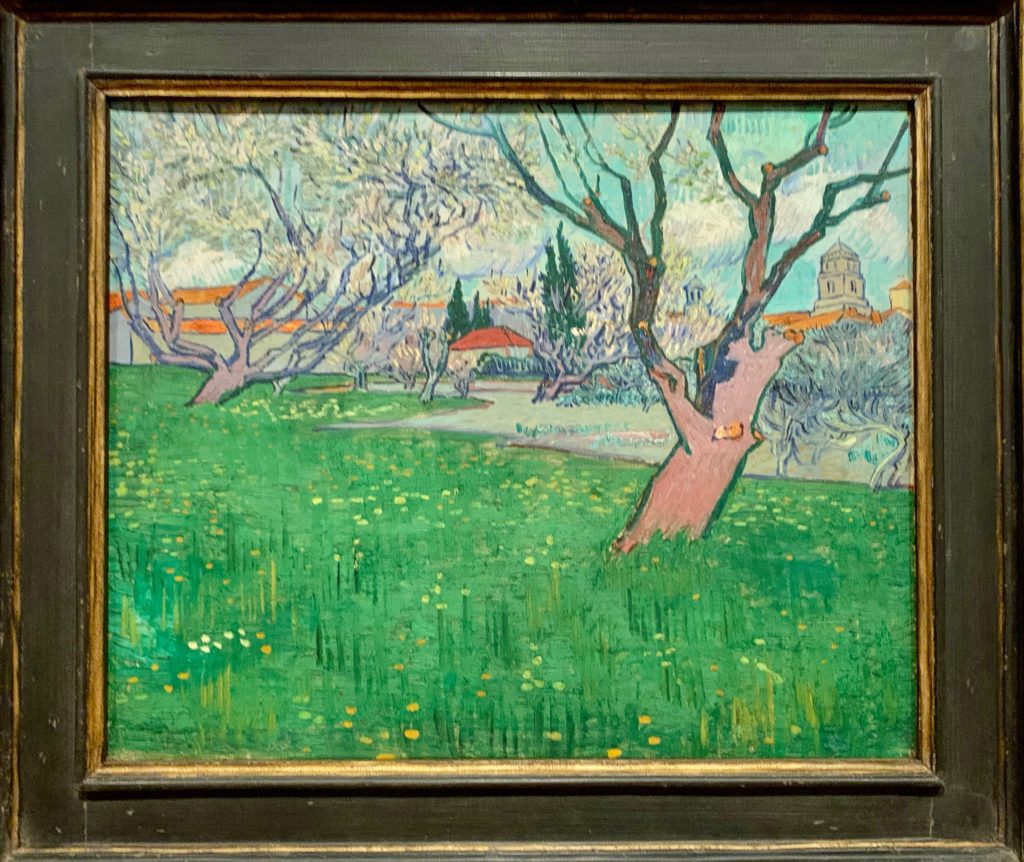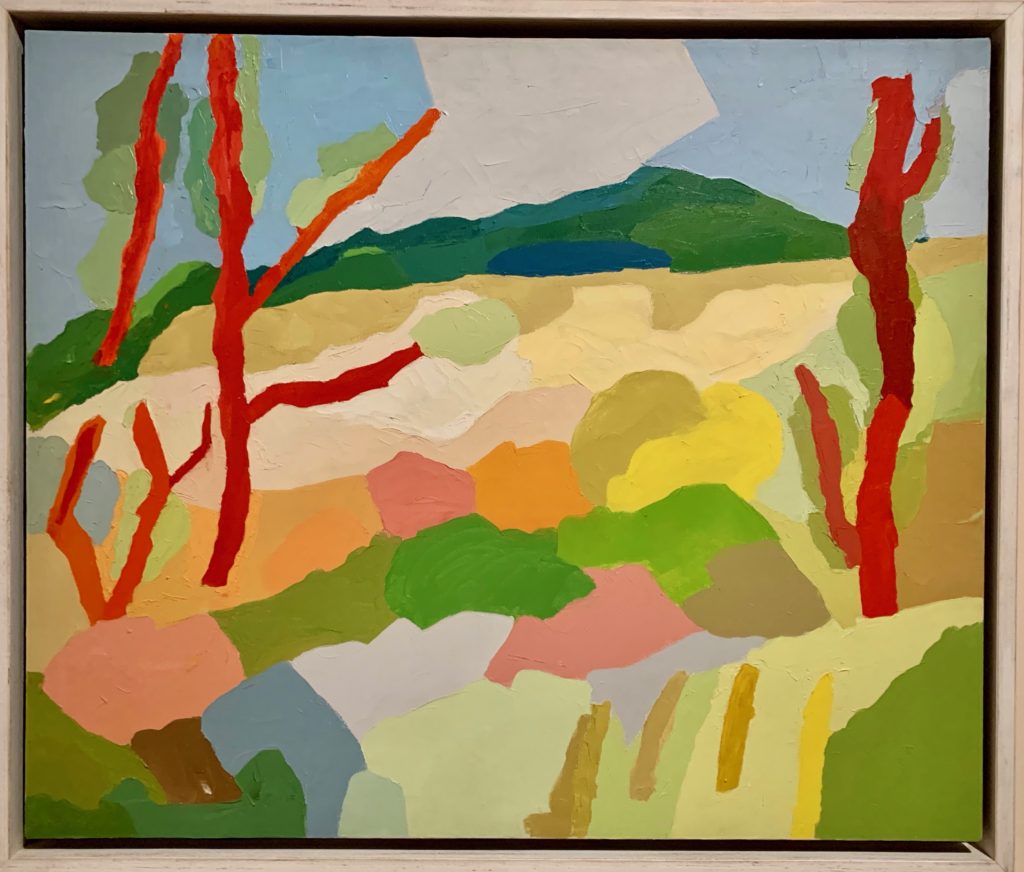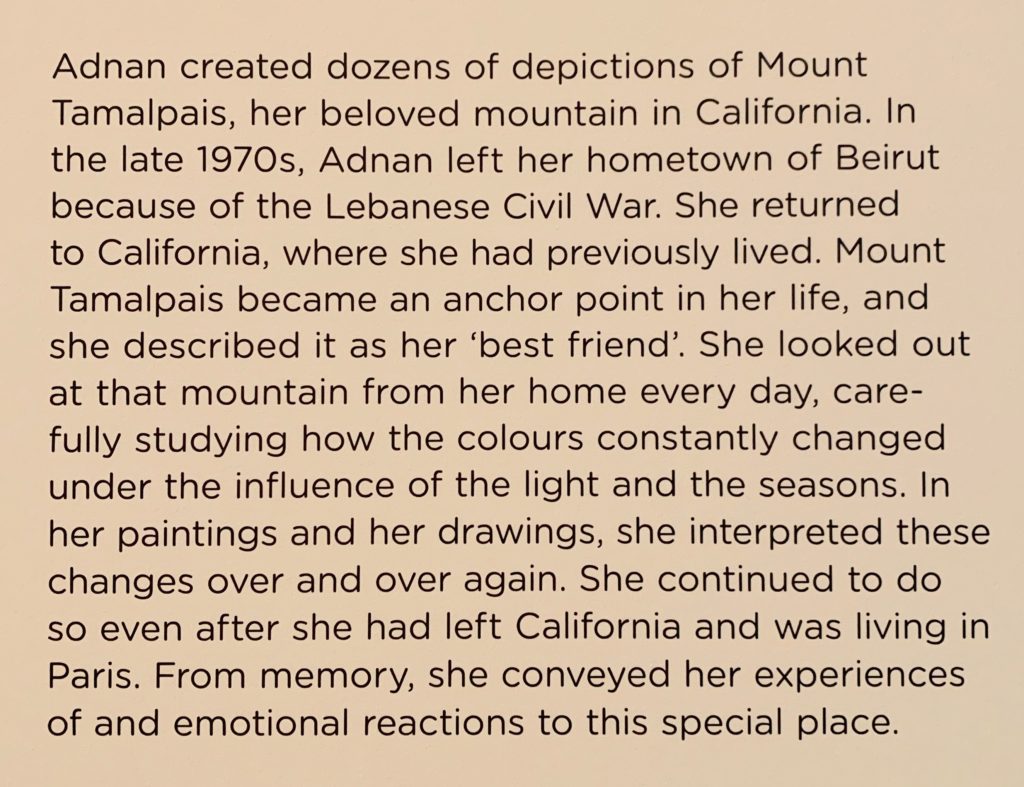Van Gogh Museum
Van Gogh is gogh-ing strong this year. Last September I saw an immersive video show of his work in Miami and again in Indianapolis. On July 12 I had the pleasure of visiting the Van Gogh Museum in Amsterdam. A new book I bought there, Masterpieces in the Van Gogh Museum, tells the story of a family that has triumphed over tragedy and made the world a better place by demonstrating and encouraging artistic collaboration.
Brotherly love: Vincent’s younger brother Theo encouraged Vincent from the beginning of his artistic career and supported him financially. Theo and his wife Jo named their only son, born January 31, 1890, Vincent. Uncle Vincent painted Almond Blossom for his newborn nephew. As the blossom heralds spring after a long winter, Vincent expressed his feeling that the birth of a child holds the promise of new life. I remember seeing this painting in an exhibition at the National Gallery in Washington in 1998; my son David, who lived in DC then, still has a poster featuring this painting. Theo was devastated when Vincent Van Gogh died of a self-inflicted gunshot wound just six months later, on July 29, 1890. An art dealer himself, he owned most of his brother’s paintings. Right away, he held an exhibition in Paris to generate attention for Vincent’s work. His own health was deteriorating rapidly, however, and Theo died just six months after Vincent. This left Jo a widow at the age of twenty-eight, with a son who was not even a year old. Together they inherited Theo’s possessions, including all the paintings, drawings, and sketches by Vincent, the brothers’ voluminous correspondence, and the artworks by other artists that they had chosen together.
Theo was devastated when Vincent Van Gogh died of a self-inflicted gunshot wound just six months later, on July 29, 1890. An art dealer himself, he owned most of his brother’s paintings. Right away, he held an exhibition in Paris to generate attention for Vincent’s work. His own health was deteriorating rapidly, however, and Theo died just six months after Vincent. This left Jo a widow at the age of twenty-eight, with a son who was not even a year old. Together they inherited Theo’s possessions, including all the paintings, drawings, and sketches by Vincent, the brothers’ voluminous correspondence, and the artworks by other artists that they had chosen together.
A devoted sister-in-law: Jo returned to the Netherlands and opened a guesthouse in Bussum to support herself and her son. Over the years she sold works from the collection both for financial reasons and to promote Van Gogh’s reputation. Jo also organized exhibitions, such as one at the Stedelijk Museum in 1905 with 474 works. Jo’s death in 1925 placed the responsibility for the collection on her son’s shoulders.
The nephew who founded the museum: Vincent’s namesake, Vincent, worked as an engineer, but still found time to oversee editions of the correspondence between his father and his uncle. After another major exhibition of his uncle’s work was held at the Stedelijk in 1930, Vincent the Engineer agreed to leave many of them on long-term loan. In 1962 the Dutch State signed an agreement with the Vincent van Gogh Foundation to be responsible for the collection and to establish a museum in Amsterdam.
Designed by Dutch architect Gerrit Rietveld, the Van Gogh Museum opened in June 1973, expecting to host perhaps 60,000 visitors per year. It now attracts over two million visitors a year. An elliptical exhibition wing designed by Japanese architect Kisho Kurokawa opened in 1999. Hans van Heeswijk Architects then developed a design by Kurokawa into the transparent Entrance Hall, which opened in September 2015. The Van Gogh family has remained involved throughout and still sits on the board of the Foundation, which manages 205 paintings, over 500 drawings, four sketchbooks, and 850 of the 903 known letters between Van Gogh and his family and friends. Art collected by the Van Gogh brothers has been enhanced by later acquisitions of paintings and drawings by Vincent’s artist friends and artists whose work he significantly influenced.
 What I appreciated about the museum was how well it was narrated in both Dutch and English and by both audio recordings and explanatory wall plaques, as you will see in this album of 60 photos I took. One plaque explains why one of the many self-portraits that Vincent did stands out from all the rest. “Van Gogh’s self-portraits were not meant to show what he was like, but were exercises in color, brushwork, and facial expression. All except for this one, that is. In “Self-Portrait as a Painter,” he presents himself as an assured artist behind his easel. Later he wrote ‘It is only in front of the easel while painting that I feel a little of life.'”
What I appreciated about the museum was how well it was narrated in both Dutch and English and by both audio recordings and explanatory wall plaques, as you will see in this album of 60 photos I took. One plaque explains why one of the many self-portraits that Vincent did stands out from all the rest. “Van Gogh’s self-portraits were not meant to show what he was like, but were exercises in color, brushwork, and facial expression. All except for this one, that is. In “Self-Portrait as a Painter,” he presents himself as an assured artist behind his easel. Later he wrote ‘It is only in front of the easel while painting that I feel a little of life.'”
In the Exhibition Wing there were fewer crowds. I was particularly struck by the exhibition Color as Language, a collection of paintings by Etel Adnan. In my photo album of her works, you can find her simplified landscapes with intense colors and abstract shapes that enter into a dialogue with works by Van Gogh.
Adnan’s unique life story is also discussed. For nearly a century she moved between different cultures and languages. The implications of growing up with a multicultural background are explored. How did this shape her life and is it reflected in her art? I was particularly struck by her painting of Mount Tamalpais in Marin County, California, near the home of my dear friend Joe Simmons. She painted it many times from various angles.
I sent Joe a copy of Adnan’s essay, Journey to Mount Tamalpais, in which she wrote “The Indian called the Mountain Tamal-Pa, “the one close to the sea.” The Spaniard called it Mal-Pais, “bad country.” The difference between the native and the conqueror is readable in these two different perceptions of the same reality.”
Etel Adnan (1925-2021) only broke through with her paintings in 2012, at the age of 87. (There’s hope for me yet.) She had already made a name for herself internationally with her literature and poetry. Adnan was an unconventional, intriguing artist, philosopher, writer, painter and activist. She grew up in Beirut, and studied in Paris and California. For years she lived and worked in both places. She passed away on 14 November 2021 at the age of 96, during the preparations for this retrospective at the Van Gogh Museum.
 One painting that was missing from the Van Gogh Museum was ‘Starry Night,” which I had seen at the Museum of Modern Art in New York City in June 2019. Sure enough, a question often asked in Amsterdam is “Where is it?” Jo had sold it to Georgette van Stolk in Rotterdam. In 1941, MoMA acquired it from her. It was the first Van Gogh to enter a New York museum collection.
One painting that was missing from the Van Gogh Museum was ‘Starry Night,” which I had seen at the Museum of Modern Art in New York City in June 2019. Sure enough, a question often asked in Amsterdam is “Where is it?” Jo had sold it to Georgette van Stolk in Rotterdam. In 1941, MoMA acquired it from her. It was the first Van Gogh to enter a New York museum collection.
By displaying and contextualizing the art of their forbear and his friends, by exhibiting works inspired by his pathbreaking efforts, and by building and maintaining a great center for artistic study and collaboration, the Van Gogh Foundation and the Dutch State have set a splendid example. I am grateful for the opportunity to see it in person.




Leave a Reply